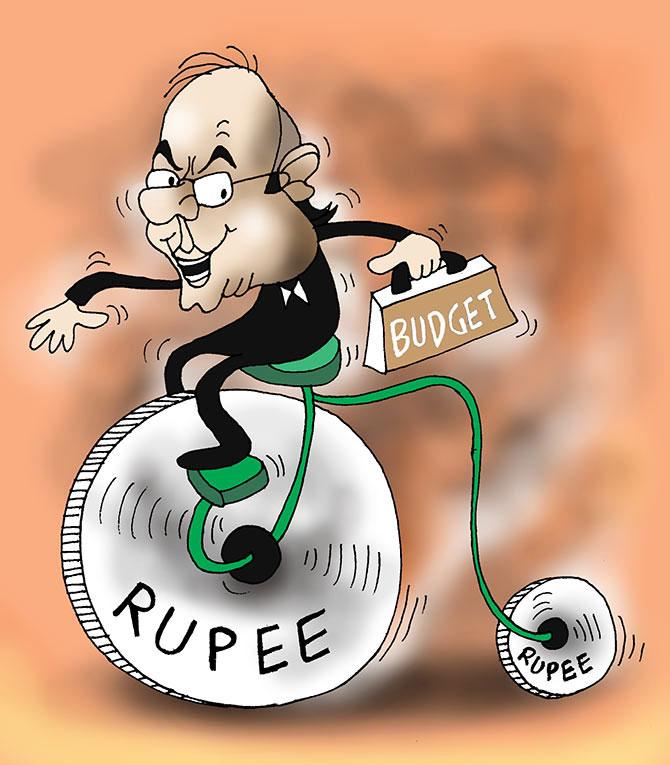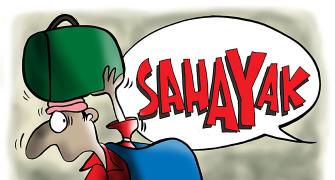Major focus will be on adequately funding existing schemes to ensure their timely completion before the next general elections.
Illustration: Uttam Ghosh/Rediff.com.

Budget 2017 is expected to focus majorly on recasting and re-orienting existing flagship programmes of the Narendra Modi government with added funds to ensure their completion before the next general elections and to make sure that benefits of schemes reach the last mile.
Officials said the rural development sector in particular could see a jump in allocations in all its major schemes and programmes, followed by schemes related to poverty alleviation and social sector.
The possibility of slew of big schemes and a lot of mega announcements looks remote, with the exception of revising income tax slabs to mollify the middle classes and a reference to the Basic Income Transfer Scheme.
The budgetary outlay could see significant increase in infrastructure, social sector schemes, micro, small and medium enterprises, rural sector and job creation.
Officials say that as long as the government can ensure last-mile delivery and better targeting of beneficiaries, the existing programmes are sufficient to reach out to millions who work in the informal sector, to rural India as also the salaried classes.
The centrally sponsored schemes, and those in which the states also contribute, have to be recast and improved upon, they said.
Such an approach is not only consistent with the prime minister’s vision to observe the current year as ‘garib kalyan varsh’, or year dedicated to the welfare of the downtrodden, but will also go towards meeting the immediate electoral challenges of the government.
- Major focus on adequately funding existing schemes to ensure their timely completion before next General Elections.
- Rural Development Sector, schemes related to poverty alleviation, social sector could see recast and re-orientation.
- No major alteration in indirect taxes likely as the GST is expected to take care of them.
- Lot of mega announcements looks remote, though tweaking in tax rates and some sort of income transfer is a possibility.
- The small and medium sector, hit hard by demonetisation could see some sops, so also micro-irrigation.
Elections to five states, including the key state of Uttar Pradesh, start within three days of the Budget being presented.
The Bharatiya Janata Party also needs to prepare for polls in Modi’s home state of Gujarat and Himachal Pradesh, which are due by December.
The government, according to officials, has found itself on the horns of a dilemma after the demonetisation exercise failed to deliver upon its expectations.
Before Prime Minister Narendra Modi’s note ban announcement on November 8, 2016, the Budget planners in the finance ministry were working on the assumption that the upcoming 2017-18 Budget will be incremental, while the 2018-19 Budget will be transformational.
The idea was to fix the gaps in and ensure better implementation of the existing schemes. The economic impact of demonetisation has meant now even 2017-18 will see a populist Budget.
The note ban decision, and its impact, impelled the Budget planners to factor in the ‘gain’ that the prime minister had promised to the people after 50 days of ‘pain’ of its currency swap decision.
With job growth at a low and impact of demonetisation likely to dent it further, the government is looking at a significant increase in funds for rural development, with special focus on poverty alleviation in rural areas through a targeted approach.
An official said the much-anticipated universal basic income scheme, or UBIS, could find a passing reference in the Budget.
According to officials, this recasting of the Budget would also mean more funds for agriculture -- kitty for existing programmes like Soil Health Cards, e-NAMs (National Agriculture Market), irrigation and micro-irrigation schemes, rather any new announcements.
But Opposition parties have waded into what is turning out to be the Modi government’s Achilles heel. On Sunday, Uttar Pradesh Chief Minister Akhilesh Yadav released the Samajwadi Party’s manifesto for the UP polls.
He said three years have passed but people are still searching for the prime minister’s promised ‘achche din’, or better days, which are nowhere to be seen.
After the current round of elections in 2017 to seven states (UP, Uttarakhand, Manipur, Punjab, Goa now; Gujarat and Himachal Pradesh later this year), there are a series of important elections in 2018.
By March of 2018, Meghalaya, Nagaland and Tripura go to polls. It will be the turn of Karnataka to elect a new Assembly in May 2018, and by end of 2018 Chhattisgarh, Madhya Pradesh, Rajasthan and Mizoram will go to polls.
The BJP is a key player in several of these states, and success here is crucial, if it is to return to power in 2019.









